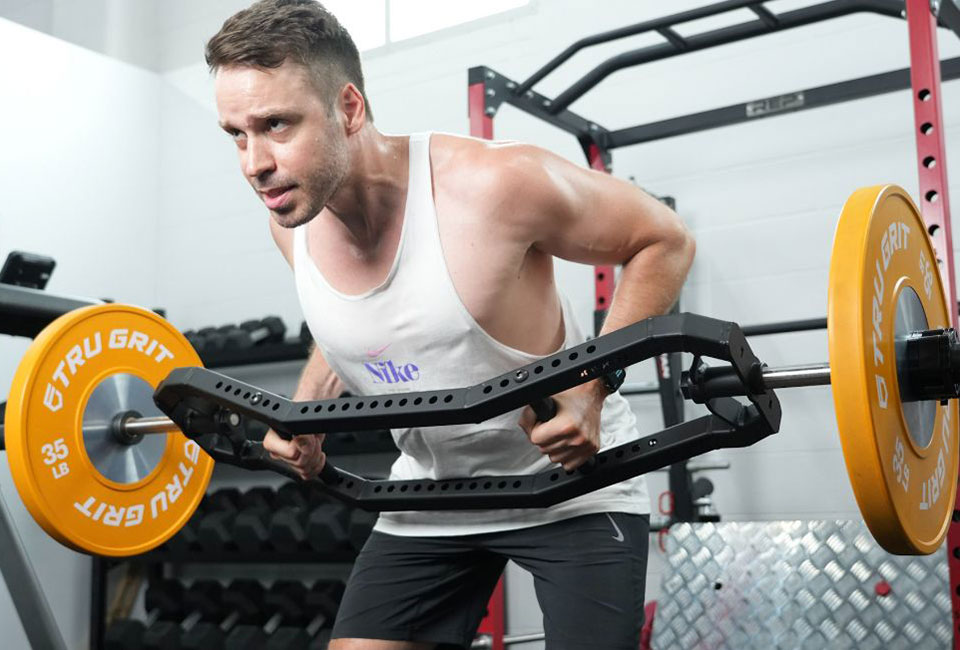We test and review fitness products based on an independent, multi-point methodology. If you use our links to purchase something, we may earn a commission. Read our disclosures.
Dedicating a day toward targeting your back muscles is pretty common in the strength training world; still, many fitness enthusiasts and casual gym-goers don’t understand the importance of strengthening their back muscles. Strong back muscles encourage good posture, enhance physical fitness, and make daily life just a tad easier by facilitating everyday tasks and staving off those pesky back-related aches and pains.
Today, we’re celebrating your all-important posterior muscles by giving you a crash course in back muscles anatomy, including the function and location of your most major back muscles. Kate Meier, NASM-CPT, USAW-L1, CF-L1, and GGR head of content, takes us back to school, providing the best back exercises, general back training tips, and a sample back workout.
We’ve got your six.
Your Back Muscles Explained
Stretching roughly from your skull’s occipital bone to the sacrum right above your pelvic bone, your back contains a staggering number of muscles, bones, tendons, ligaments, and nerves.
Regarding physical fitness, there are only a handful that bear the brunt of the work during exercise. Here’s a little background on these crucial back muscles.
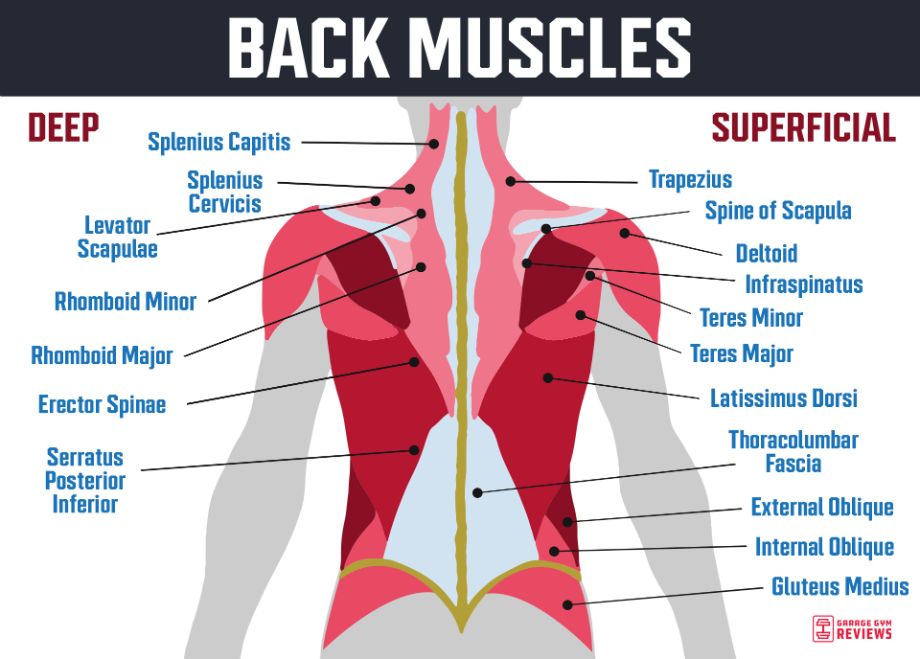
Latissimus Dorsi
The latissimus dorsi1, commonly referred to as the lats, are two broad, flat muscles that stretch bilaterally from the thoracolumbar fascia, located just above the iliac crest of your pelvis, to the humerus of the upper limb.
“The lats assist in various arm movements, including rotation, extension, and adduction,” says Kate Meier, NASM-CPT, USAW-L1, CF-L1. “That makes them integral for pulling movements and exercises such as pull-ups, pull-downs, and rowing.”
Trapezius
The trapezius2 is a trapezoidal muscle that stretches from the base of your neck and across your shoulders before traveling down the dorsal spine and terminating in the mid-back. Because of its size, it’s further subdivided into the upper, middle, and lower trapezius.
“The trap muscles assist in moving the head and neck, retracting the shoulder blades when standing upright, and twisting the torso,” says Kate.
Rhomboids
The rhomboids3, consisting of the rhomboid major and rhomboid minor, stretch horizontally beneath your spine and levator scapulae to connect your shoulder blades. They facilitate scapular retraction and assist in stabilizing your shoulder girdle.
Posterior Deltoids
Your deltoids4 are technically a shoulder muscle. However, they’re subdivided into three portions based on their location, with the anterior deltoid on the front of the shoulder, the medial delt in the middle, and, you guessed it, the posterior deltoids in the rear.
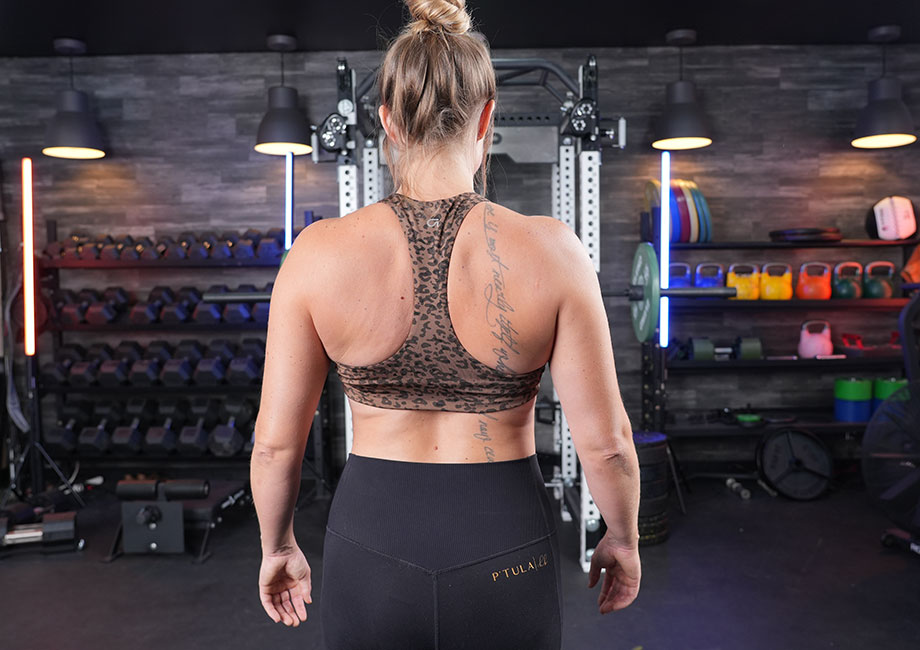
RELATED: Best Deltoid Exercises
“The posterior deltoids often work in conjunction with the lats to enable a variety of arm movements, including extension, external rotation, and horizontal abduction,” says Kate.
Erector Spinae
The erector spinae muscles run from the base of your neck to your pelvic bone, working to stabilize your spine. They work with the gluteal muscles to provide postural stability, as well as acting as a spinal extensor.
Additionally, the erector spinae5 is part of the intermediate muscles group, sometimes called the erector spinae group. The group also includes the longissimus, iliocostalis, and spinalis, which enable thoracic cage movements and flexion of the upper vertebral column, as well as the serratus posterior superior and serratus posterior inferior, which facilitate breathing.
RELATED: Thoracic Mobility Exercises
Many of these muscles are subdivided depending on the location. For example, the longissimus capitis is located in the neck and upper back, whereas the longissimus thoracis or iliocostalis thoracis will be located on the backside of the thorax, or approximately mid-back.
Intrinsic Back Muscles
Beyond the superficial back muscles, various intrinsic or deep back muscles contribute to your body’s function in many ways.
The semispinalis, rotatores, and multifidus muscles assist with balance and proprioception, maintaining posture, and move the vertebral column, whereas the splenius cervicis and splenius capitis allow you to move your neck and shoulders more fluidly.
Best Exercises for Your Back
Strengthening your back muscles promotes good posture, enhances sport performance, facilitates the ability to complete everyday tasks, and provides relief from low back pain6.
Here are a few of the best back exercises for your next strength training session.
Bent-Over Barbell Row
Back muscles targeted: Lats, traps, delts, rhomboids, and erector spinae
Why do it: The bent-over barbell row targets major muscle groups in your back and arms. A barbell allows you to load and move more weight compared to rowing variations like dumbbell rows, thus increasing your training volume. Also, because you’re rowing from a hinged position, your lower back and core will work hard to keep your torso stabilized.
How to do it:
- Stand over a loaded barbell with your feet shoulder-width apart.
- Push your hips back, keeping your chest tall, core tight, and back straight, and bring your torso forward to reach down and grip the barbell with an overhand grip.
- Deadlift the bar to waist height, then push your hips back again to lower the bar to knee height. This is your starting position.
- Pull the bar into your sternum, squeezing your shoulder blades at the top.
- Slowly lower the bar back to the starting position.
- Repeat for reps.
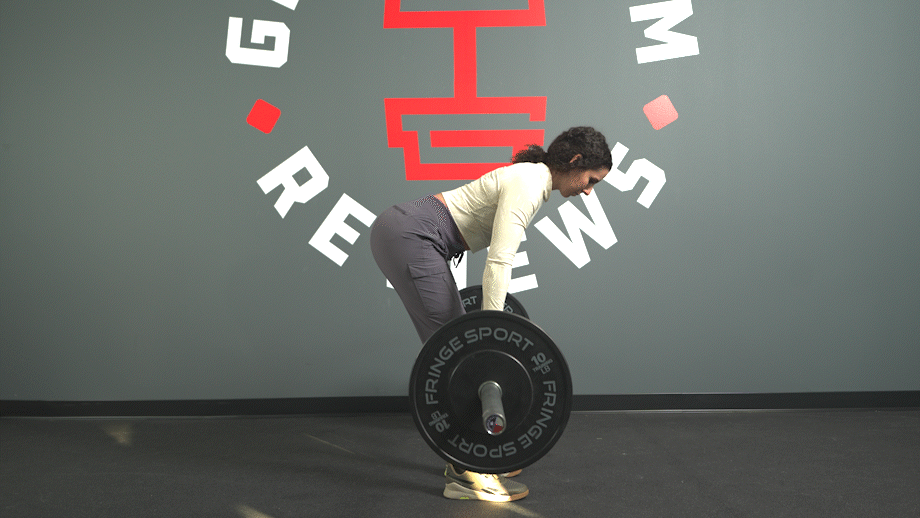
Note: If stability isn’t part of the lifting equation for you and your focus is primarily on building your back muscles, we suggest trying row variations such as a cable or chest-supported row.
RELATED: Bent-Over Row Alternatives
Deadlift
Back muscles targeted: Lats, traps, delts, rhomboids, and erector spinae
Why do it: “The deadlift is widely regarded as one of the best weight lifting exercises of all time,” says Kate Meier, NASM-CPT, USAW-L1, CF-L1. “Deadlifting strengthens muscles throughout the entire body, improves posture, and burns calories, but, most importantly, it’s a functional movement most people use every day.”
How to do it:
- Stand over a loaded barbell with your feet shoulder-width apart.
- Bend your knees and push your hips back to lower yourself toward the barbell.
- Grip the bar using a mixed or overhand grip, keeping your shoulder blades retracted.
- Push through your heels, extend your knees, and thrust your hips forward to stand.
- Squeeze your glutes at the top, then slowly lower the bar back toward the floor.
- Reset and repeat for reps.
RELATED: Hip Hinge Exercises
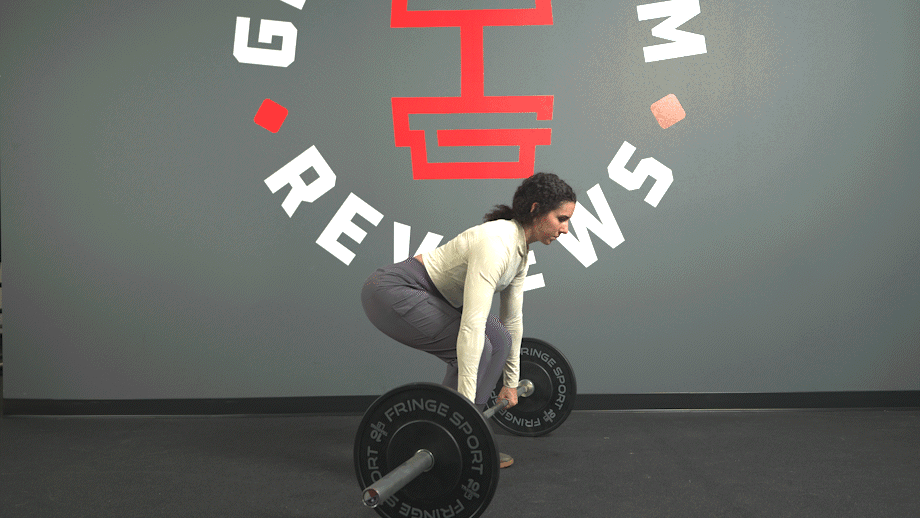
Back Extension
Back muscles targeted: Erector spinae, quadratus lumborum, posterior chain
Why do it: Studies show7 that performing back extensions may increase core and trunk stability while increasing the lumbar spine’s range of motion. Back extensions are also super versatile, as they may be performed using minimal or no equipment.
How to do it:
- Adjust a back extension machine to your preferences.
- Step onto the machine and fold your body forward by bending your hips and bringing your torso forward towards the floor.
- Use your lower back and core muscles to achieve an upright position.
- Hold the position, then slowly lower yourself back down.
- Repeat for reps.
RELATED: How to Do Back Extensions At Home
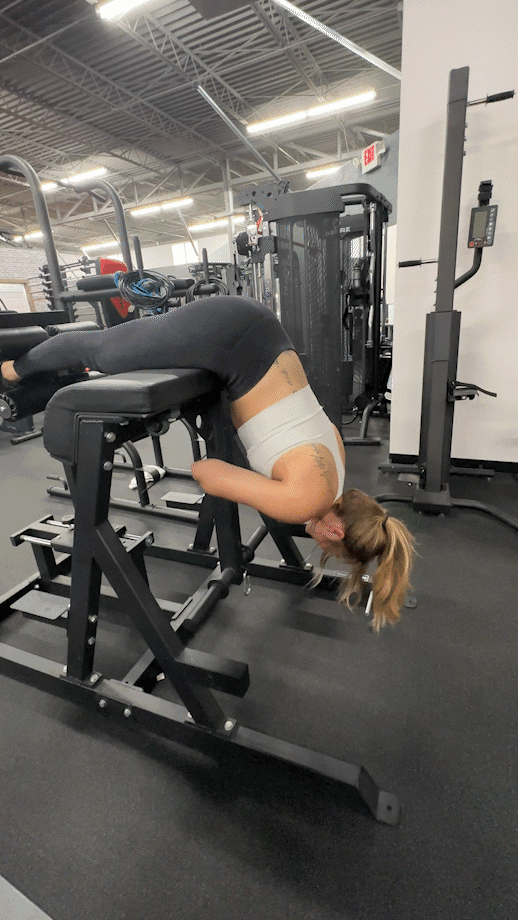
High Pull
Back muscles targeted: Rhomboids, delts, traps, lats
Why do it: “Performing high pulls will help build strength and muscle in your back, shoulders, arms, and core,” says Kate, “but they’re mostly useful for improving power production. Doing high pulls regularly should translate nicely to sports, Olympic lifts, and everyday life, too.”
How to do it:
- Stand with your feet shoulder-width apart and a loaded barbell held with arms fully extended. Keep your chest tall, core tight, back straight, and eyes fixed forward.
- Pull the barbell to your chin, keeping it close to the body at all times.
- Hold the end position briefly, then slowly lower the bar back to the starting position.
- Reset and repeat for reps.
RELATED: Best Exercises for Upper Back
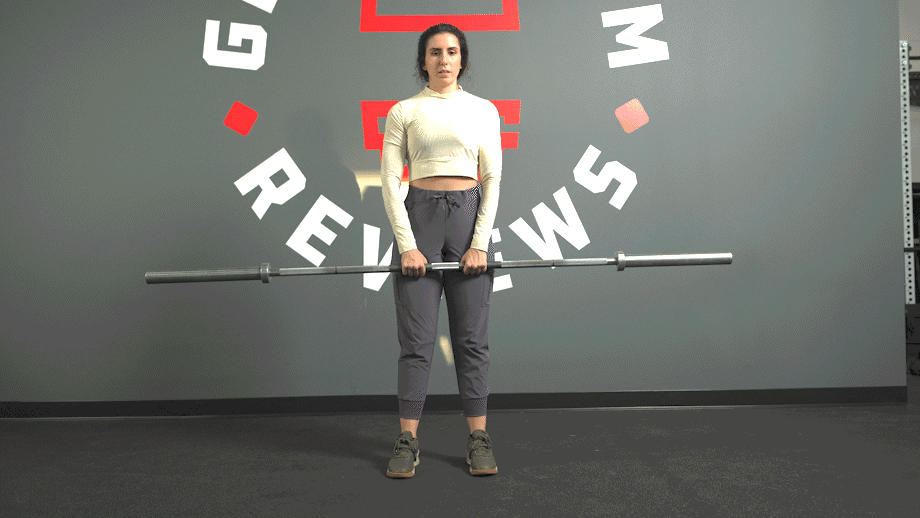
Seated Cable Row
Back muscles targeted: Lats, rhomboids, traps, rear delts
Why do it: Standing back exercises often recruit muscles from surrounding muscle groups, so you wind up sharing the wealth. Sitting down, on the other hand, helps isolate the back muscles, so movements like the lat pulldown exercise and seated cable row are integral to a well-rounded back workout.
How to do it:
- Select your preferred attachment and fasten it to your cable machine. You may select the V-grip, straight bar, or EZ-bar, depending on which muscles you want to target most.
- Adjust the machine to your specifications and sit down, placing your feet on the pads.
- Slide back until you’re holding the attachment with arms fully extended.
- Pull the attachment into your lower abdomen, pinching your shoulder blades.
- Hold the position, then slowly guide the attachment back to the starting position.
- Reset and repeat for reps.
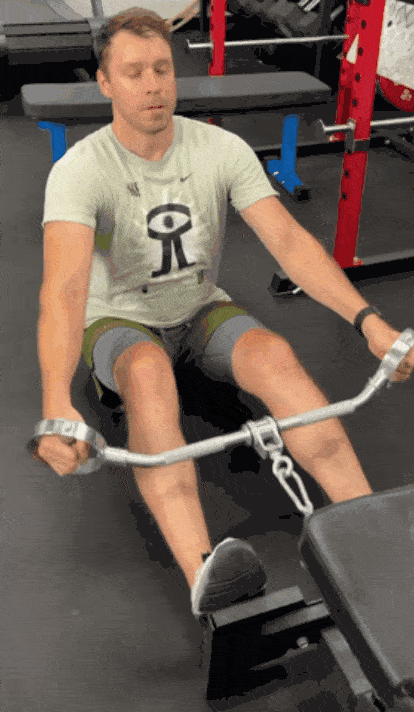
Pull-Up
Back muscles targeted: Lats, rhomboids, delts, traps
Why do it: Pull-ups are one of (if not the) most challenging and effective bodyweight exercises, targeting muscles throughout your back, shoulders, arms, and core. Adding pull-ups into your workout routine should help you majorly improve your muscle size and strength.
How to do it:
- Grab hold of a pull-up bar using an overhand grip and enter a dead hang.
- Using only your arms and back muscles, pull yourself towards the bar.
- Continue until you bring your chin over the bar.
- Squeeze your lats, then slowly lower yourself back into a dead hang.
RELATED: What Muscles Do Pull–Ups Work?
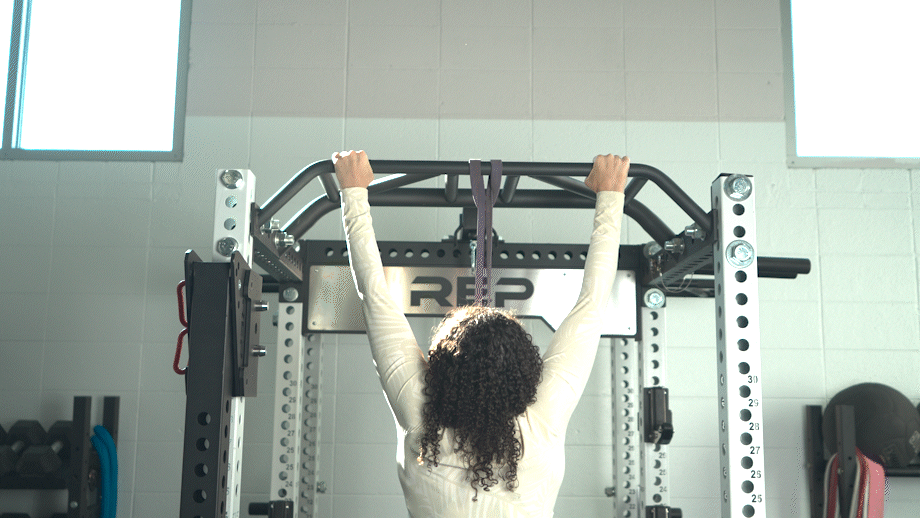
Single-Arm Dumbbell Row
Back muscles targeted: Lats, traps, delts
Why do it: “Working out bilaterally has its merits, but it’s also important to incorporate unilateral exercises, too, to correct muscle imbalances, address bilateral deficits, and really isolate the target muscles,” says Kate. “The single-arm dumbbell row is a great example of that.”
How to do it:
- Stand with a weight bench at your side. Place your right hand and right knee on the bench, holding a dumbbell in your left hand and keeping your left foot firmly planted.
- Keeping your left elbow close to the body, your back straight, your core tight, and your neck neutrally aligned, pull the dumbbell into your body.
- Squeeze the contraction in the end position.
- Slowly bring the dumbbell back down.
- Repeat as needed, then switch sides and repeat the set.
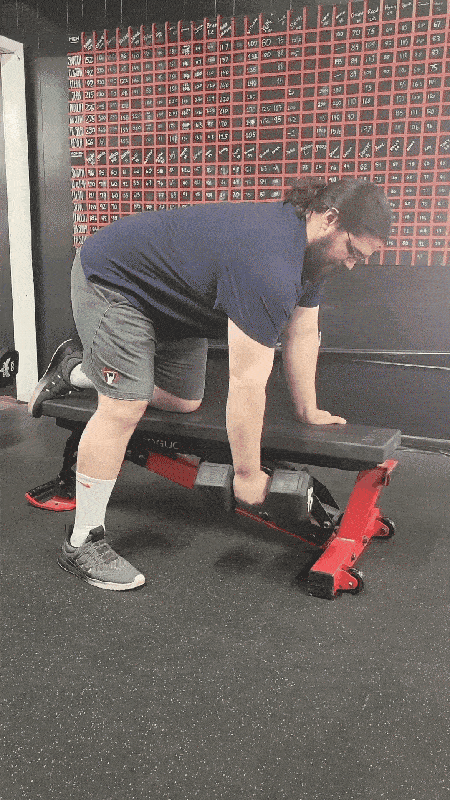
Face Pull
Back muscles targeted: Delts, traps, rhomboids
Why do it: The face pull works well to isolate the back muscles, specifically the upper back muscles. It also provides a different stimulus to your muscles since it uses a resistance band or cable machine rather than regular old free weights, making it a worthwhile addition to any back strength training routine.
How to do it:
- Attach a rope attachment to your cable machine and set it to shoulder height.
- Grip the rope using an overhand grip with your thumbs pointed up.
- Step back until your arms are nearly fully extended. You should feel a stretch in your upper back. Brace your core, keep your chest tall, and bring your shoulders down.
- Pull the rope towards your face, pinching your shoulder blades together at the end.
- Squeeze the contraction, then slowly guide the rope back to the starting position.
- Repeat for reps.
RELATED: Best Cable Machine for Your Home Gym
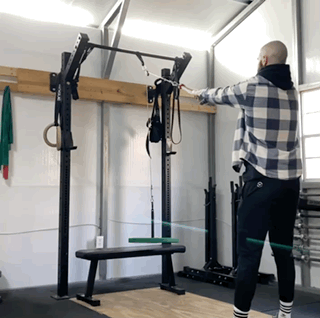
Back Training Tips
Are you ready to take this newfound knowledge of back muscles anatomy and put it into action? If so, you’re going to want to work smart, not only to make your workouts more effective but to minimize your risk of injury, too.
Form Comes First
Training with improper form puts your body in a precarious position where you’re more likely to suffer an injury. With your back, that’s even more pertinent, since certain parts of the cervical spine, like the supraspinous ligaments, and other delicate deep and superficial back muscles are especially susceptible to sports-related injuries.
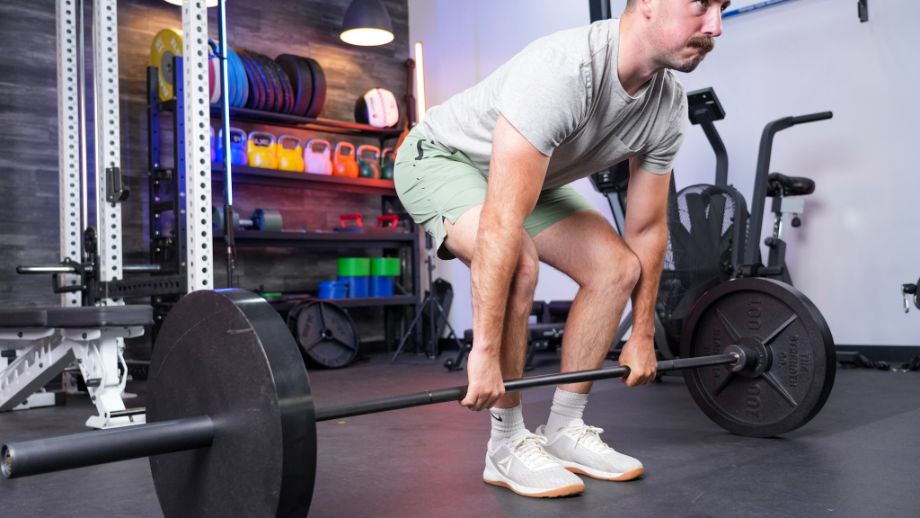
According to a 2020 study in Cureus8, the most common causes of low back pain in young weightlifters were “using excessive weights and performing improper techniques [that put] the back in a compromising position.”
If you find your form falling apart from fatigue or inexperience, switch to lighter weights, perform the move with no resistance, or consider working with a certified personal trainer until you have everything down pat.
RELATED: Best Online Personal Trainer
Pull to Your Sternum, Not Your Clavicle
Exercises like the bent-over row, pull-up, and lat pulldown revolve around pulling. Beginners may mistakenly pull the weight or the pull-up bar to their clavicle, but this hinders your ability to retract your shoulder blades.
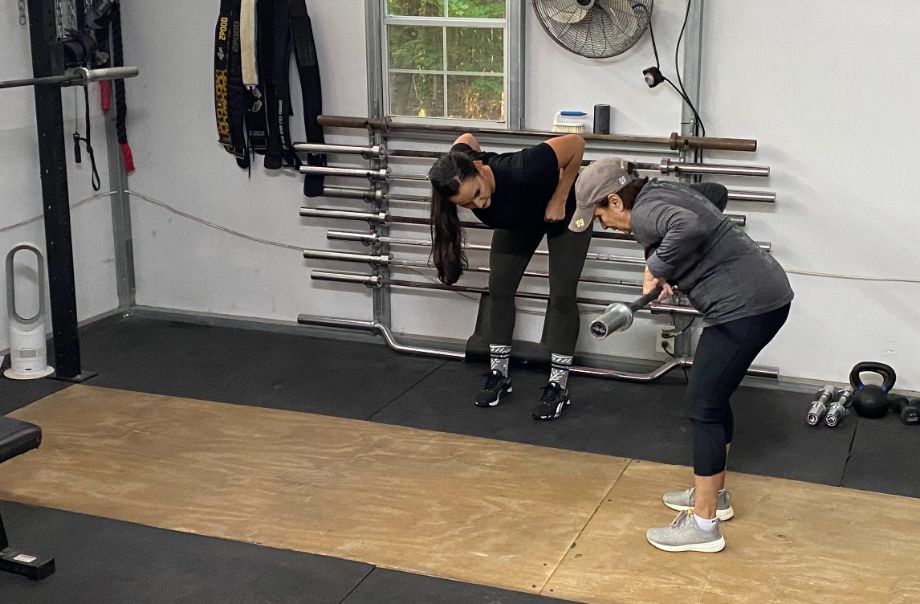
“Pulling without your shoulder blades retracted limits the amount of power you can produce to complete the lift or exercise,” says Kate Meier, NASM-CPT, USAW-L1, CF-L1. “Pulling to the sternum, on the other hand, allows perfect scapular retraction and increases the activation in the lat muscles.”
Use a Full Range of Motion
Maintain a full and natural range of motion on each rep; no short reps but no dramatically exaggerated reps either. If you’re unsure of how far is too far, consider working with a certified personal trainer or other qualified fitness professional.
Sample Back Workout
We’ve discussed a lot of what makes a good back workout in theory, but it’s time to put it into practice. Now, we realize that six exercises is a big ask for a back day (or any dedicated muscle group day, for that matter), so you can pick-and-choose by breaking this up into two movements at the lower rep range and two movements at the higher rep range for four total exercises. Feeling spicy? Add a fifth or sixth movement.
| Exercise | Sets | Reps |
| Bent-Over Barbell Row | 3 to 5 | 4 to 6 |
| High Pull | 3 to 5 | 4 to 6 |
| Deadlift | 3 to 5 | 4 to 6 |
| Back Extension | 3 to 6 | 8 to 12 |
| Pull-Up | 3 to 6 | 8 to 12 |
| Face Pull | 3 to 6 | 8 to 12 |
Program Notes
The front portion of this workout is strength heavy, meaning you’ll be doing less reps but should use a weight that’s closer to your one-rep max. Anywhere between 60% and 80% should work nicely here.
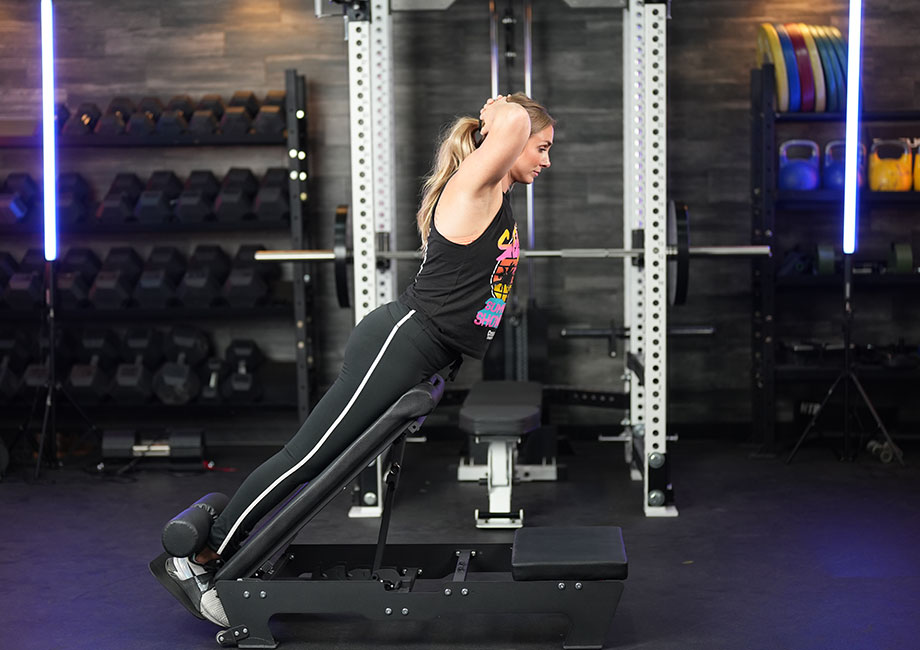
Since the back extensions and pull-ups are typically performed without resistance, we’re adding some extra reps to get that heart rate going, burn calories, and help build your endurance. The face pulls follow this rep scheme, too, so be sure to select approximately 40% to 60% of your one-rep max (1RM) to ensure you have the stamina to complete your reps here.
Don’t forget to rest between sets and exercises. Anywhere between one and three minutes works nicely, especially for the heavier sets in the beginning. Beginners, on the other hand, should always feel free to rest as needed.
Back Muscles Anatomy: Final Thoughts
Let’s go back and review everything we just covered about your back muscles anatomy:
- Your back consists of many major muscles, namely the latissimus dorsi, trapezius, rhomboids, posterior deltoids, and erector spinae.
- The back muscles primarily work to support your spine and assist in the movement of your arms, neck, and trunk.
- Incorporating back exercises will strengthen these crucial muscles and provide various benefits, ranging from everyday practical perks to sport-specific advantages.
So, whether you’re a young athlete looking for the athletic edge, a middle-aged adult looking to promote better general fitness and wellness, or an older adult working to alleviate the effects of aging, knowing a thing or two about your back muscles anatomy is sure to come in handy.
Combined with the best back exercises and a great back workout, you’ll never feel like your back is up against the wall when it comes to your health!
RELATED: Back Workout with Dumbbells
Back Muscles Anatomy: FAQs
What are the 5 major muscles of the back?
There are a multitude of intrinsic back muscles that contribute to your overall good health and well-being, but the five major ones are predominantly extrinsic back muscles that occupy the superficial layer of your back’s musculature.
The five major muscles of the back are:
– Latissimus dorsi
– Trapezius
– Rhomboids
– Posterior deltoids
– Erector spinae
Which muscle is responsible for back pain?
The frustrating thing about back pain is that it could occur in any of the many back muscles. Tension, stiffness, or improper form during weightlifting could lead to soreness in the traps or lats. Poor posture could contribute to conditions such as non-specific low back pain.
Ultimately, the muscle that’s responsible for your back pain will depend on where you’re experiencing the pain, the type of pain, and the intensity. Consult your doctor for a proper diagnosis and treatment plan if the pain is beyond standard exercise-related soreness.
How do you loosen tight lower back muscles?
Tight lower back muscles are a literal pain, but you may enjoy some relief by regularly performing strength training of the lower back muscles. Mobility exercises, static stretching, heat therapy, massage, yoga, and Pilates all may assist in loosening up those tight muscles as well.
How do I know if back pain is muscular?
Muscle soreness is normal if you’re getting in a good workout, but some fitness enthusiasts leave the gym fearing they may have really overdid things and caused other types of damage.
The spinal nerves, including accessory nerves and the cluster of nerves known as the brachial plexus, are especially susceptible to injury if you’re working with excessive weight or using improper technique. Often, individuals suffering from nerve damage report numbness or tingling sensations rather than pain.
Damage to the spinal cord, including the cervical vertebrae, thoracic vertebrae, or lumbar vertebrae, as well as the spinous processes or transverse processes, could lead to serious complications and may require immediate medical intervention.
If you suspect your back pain is something more serious than garden variety muscle soreness, it’s important to consult your primary physician or other qualified medical professional immediately.
References
1. Jeno SH, Varacallo M. Anatomy, Back, Latissimus Dorsi. [Updated 2023 Mar 5]. In: StatPearls [Internet]. Treasure Island (FL): StatPearls Publishing; 2023 Jan
2. Ourieff J, Scheckel B, Agarwal A. Anatomy, Back, Trapezius. [Updated 2023 Mar 11]. In: StatPearls [Internet]. Treasure Island (FL): StatPearls Publishing; 2023 Jan
3. Farrell C, Kiel J. Anatomy, Back, Rhomboid Muscles. [Updated 2023 May 16]. In: StatPearls [Internet]. Treasure Island (FL): StatPearls Publishing; 2023 Jan
4. Elzanie A, Varacallo M. Anatomy, Shoulder and Upper Limb, Deltoid Muscle. [Updated 2023 May 8]. In: StatPearls [Internet]. Treasure Island (FL): StatPearls Publishing; 2023 Jan
5. Henson B, Kadiyala B, Edens MA. Anatomy, Back, Muscles. [Updated 2023 Aug 14]. In: StatPearls [Internet]. Treasure Island (FL): StatPearls Publishing; 2023 Jan
6. Kim D, Cho M, Park Y, Yang Y. Effect of an exercise program for posture correction on musculoskeletal pain. J Phys Ther Sci. 2015;27(6):1791-1794. doi:10.1589/jpts.27.1791
7. Yaprak Y. The effects of back extension training on back muscle strength and spinal range of motion in young females. Biol Sport. 2013;30(3):201-206. doi:10.5604/20831862.1047500
8. Fares MY, Fares J, Salhab HA, Khachfe HH, Bdeir A, Fares Y. Low Back Pain Among Weightlifting Adolescents and Young Adults. Cureus. 2020;12(7):e9127. Published 2020 Jul 11. doi:10.7759/cureus.9127
Further reading

We pulled together all the best Labor Day sales on fitness equipment as well as tips for finding deals. Save money on barbells, dumbbells, treadmills, ellipticals, supplements, and more. Read more

Looking for a high-value air bike? Our Fringe Sport Raptor Air Bike review looks at one of the latest machines to hit the market. Read more

Looking for a Pullup & Dip coupon code to save money on your next purchase? We have a GGR exclusive deal just for you. Read more

Our Bells of Steel Blitz Air Rower review reveals just how similar—or not—this Concept2 dupe is to the real thing. Read more

